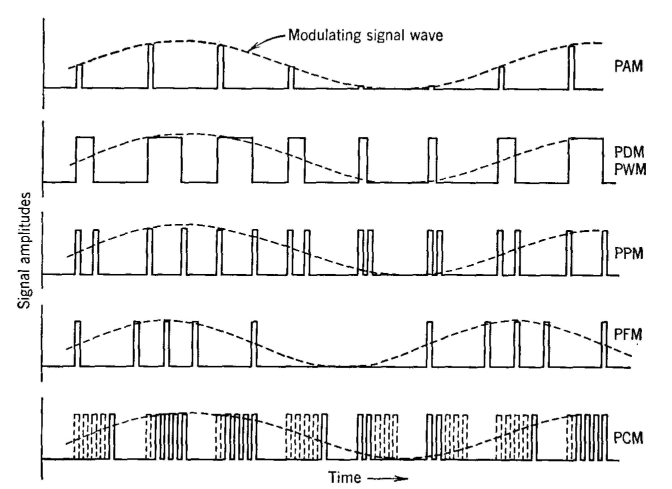| Electrical Communication is a free textbook on the basics of communication technology. See the editorial for more information.... |

|

Home  Radio Systems Radio Systems  Pulse Modulation Pulse Modulation |
|||






|
|||
Pulse ModulationMethods that are generally termed pulse modulation are under intensive experimental study and are used to some extent in practice, particularly with radio-relay systems. A study of this subject is complicated by the fact that it is in the developmental state, It is not evident which systems will eventually achieve wide usage, although the last one to be described is very promising. When pulses instead of a sine-wave carrier are used, a large number of possible modulation methods are available. Perhaps what is called pulse modulation could be described as pulse sampling, and the general method described as communication by samples.65 Several possible pulse-modulation schemes will be described.65,66,67 In Fig. 31 is shown a chart for explaining certain types of pulse modulation. Sinusoidal modulating signals are shown for convenience. In pulse-amplitude modulation or PAM2 the signal to be transmitted is sampled at regular intervals, and pulses of equal width but of varying amplitude are transmitted. The receiver must measure the amplitude, or voltage, of each pulse and then reproduce the modulating signal voltage.65 In pulse-duration modulation, or PDM,2 also called pulse-length modulation, or PLM,65 and pulse-width modulation, or PWM,66 the signal to be transmitted is sampled periodically, and pulses whose duration, or length, or width, which vary with the instantaneous magnitude of the signal, are transmitted. The receiver must measure the time duration of the arriving pulses and reconstruct the original modulating signal from these time measurements.65
In pulse-position modulation, or PPM,2 the amplitude of the pulses and their width remain constant, but the time at which they are transmitted depends on the instantaneous magnitude of the signal. The receiver must measure the time arrival of the signal and reconstruct the original modulating signal from this information.65 In pulse-frequency modulation, or PFM, the repetition frequency of the pulse is varied.66 In pulse-code modulation, or PCM,65,68,68(a) also called pulse-count modulation,66,67 the amplitude range of the modulating signal is divided into a number of discrete levels, and these are sampled at regular intervals. Pulses bearing the information as to signal level are transmitted in groups, one group for each sample, and one or more pulses of a group are omitted to deliver specific data regarding the amplitude range of a sample. This is at present the most important system. The receiver must note the presence or absence of individual pulses in a group and reconstruct the modulating signal. The circuits used for these systems of communication are different from ordinary circuits previously discussed, and, in fact, some of them involve the use of special vacuum tubes.69,70,71 The preceding paragraphs are descriptions. Definitions2 applying to certain types of pulse modulation have been formulated as follows: Pulse-Amplitude Modulation or PAM. Modulation in which the modulating wave is caused to amplitude-modulate a pulse carrier. Pulse-Time Modulation or PTM. Modulation in which the values of instantaneous samples of the modulating wave are caused to modulate the time of occurrence of some characteristic of a pulse carrier. Pulse-Duration Modulation or PDM. Pulse-time modulation in which the value of each instantaneous sample of the modulating wave is caused to modulate the duration of a pulse. Pulse-Position Modulation or PPM. Pulse-time modulation in which the value of each instantaneous sample of a modulating wave is caused to modulate the position in time of a pulse.
|
|||
Home  Radio Systems Radio Systems  Pulse Modulation Pulse Modulation |
|||
Last Update: 2011-05-30


